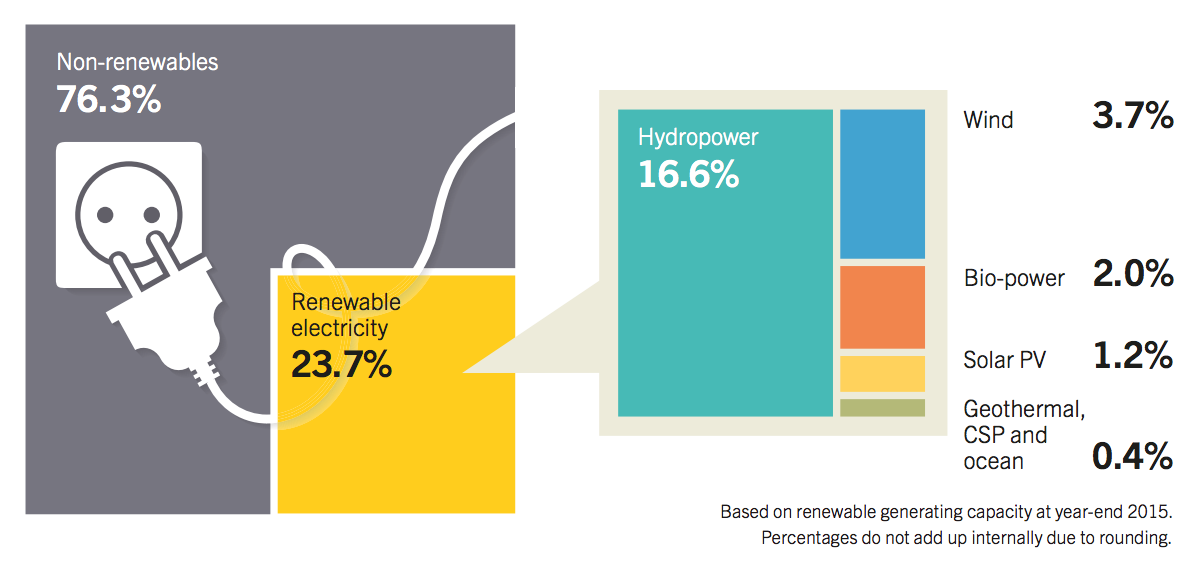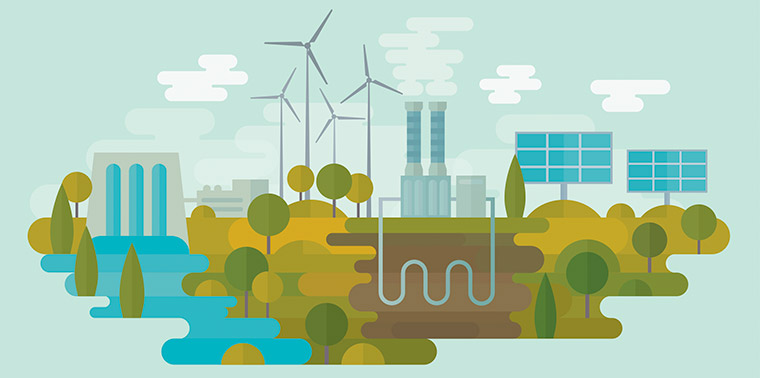January 20, 2017 — In the wake of the 2016 presidential election, the proliferation of misinformation on social media is finally getting the attention it deserves. Or so I thought.
Scrolling through my Facebook news feed recently, I stumbled upon an article shared by Climate Central, a nonprofit news organization focused on climate science. “The World’s Renewable Energy Capacity Now Beats Out Coal,” read the headline from Co.Exist. I clicked. “The tipping point marks a major milestone in the transition to cleaner power sources,” the subhead declared from atop an aerial photo of a wind farm.
And so went most of the coverage of a new report on renewable energy markets by the International Energy Agency, a well-respected source of global energy statistics. Outlets big and small, reputable and lesser-known, specialized and general, adopted similar headlines, subheads and ledes, accompanied by photos of wind turbines and solar panels.
“Installed capacity is not really a useful metric for a lot of purposes.” –Mark JacobsonThe problem is twofold. First, capacity is a highly selective way to measure electricity, especially in the context of emissions and climate change. Capacity is defined as the maximum electric output a generator can produce under specific conditions at a moment in time — for example, how much a solar farm can generate during a sunny summer day or a wind farm when it’s really windy. But, of course, the sun doesn’t always shine or the wind always blow.
“Installed capacity is not really a useful metric for a lot of purposes,” Mark Jacobson, an engineering professor at Stanford University who studies renewable energy, told me. “When you’re asking, ‘how much is this supplying, how much is wind supplying versus coal?’ you want to look at the actual energy delivered.”
That’s commonly called generation, and is defined as the amount of electricity produced on average over a period of time, such as a year. Sure enough, if you look at generation numbers, coal still beat out renewables in 2015 by a significant margin, 39 percent to not quite 24 percent.

Courtesy of Global Status Report. Read more at www.ren21.net/status-of-renewables/global-status-report/
Second, and perhaps more importantly, most readers, and apparently many journalists, equate “renewables” with wind and solar. But the IEA’s renewables category also includes hydropower and biomass. According to the IEA, 71 percent of global renewable electricity generation in 2015 came from hydropower, 15 percent from wind, 8 percent from bioenergy and 4 percent from solar. In other words, it’s not wind and solar that have overtaken coal, it’s a basket of renewables heavily dominated by hydropower. While growth in wind and solar installations have certainly helped push renewables’ share up, hydropower also has been growing in recent years. When you include all sources, hydropower currently generates around 16 percent of the world’s electricity; wind, almost 4 percent; biopower, 2 percent; and solar, just above 1 percent.
These two subtle forms of miscommunication, I believe, have led to some unfortunate misperceptions. A recent survey found that, on average, Americans believe that the country gets 20 percent of the total energy it consumes from wind and solar (11 percent wind, 9 percent solar). Part of this is likely due to the common but erroneous conflation of “energy” and “electricity.” But even if you look at just electricity, the numbers for the U.S. still don’t come close to 20 percent. The U.S. Energy Information Administration’s 2015 statistics show that 4.7 percent of the country’s electricity was generated from wind, with 0.6 percent coming from solar. That’s a 14-plus percentage point difference between what Americans think and the truth.
It’s hard to blame them, with confused and confusing coverage of renewable energy statistics popping up in their social media feeds and on news outlets they’ve come to trust. On top of that, most social media sharers never even read the articles they share. According to a recent study, 59 percent of links shared on Twitter have never been clicked, underscoring the outsize influence of misleading headlines, subheads and header photos. And research has shown that misleading and clickbait headlines have a lasting effect on how those who actually read articles interpret and remember their content.
Making wind and solar seem like they’re doing better than they really are could come back to bite them — and the climate.“This is typical of modern information consumption,” said Arnaud Legout, co-author of the study on social media sharing, in a statement. “People form an opinion based on a summary, or a summary of summaries, without making the effort to go deeper.”
It’s understandable that environmental organizations and activists would want to build public enthusiasm for renewable energy. But making wind and solar seem like they’re doing better than they really are could come back to bite proponents — and the climate. If members of the public think we’re well on our way to throwing fossil fuels into the dustbin of history and replacing them with renewables, they’ll be less likely to demand new policies and take actions to lower their own carbon footprints. The public may even come to see wind and solar as capable of outcompeting fossil fuels on their own and therefore undeserving of government subsidies and helpful regulations.
Wind and solar have made real progress in recent years. Their costs are projected to continue to decrease, and more wind and solar farms and rooftop solar arrays will continue to pop up across the country and around the world. But if the goal is to limit warming to anywhere near the level world leaders agreed to in Paris in 2015, significant challenges remain — and pretending like everything is going great is not going to fix them. ![]()
Editor’s note: The views expressed here are those of the author and not necessarily of Ensia. We present them to further discussion around important topics. We encourage you to respond with a comment below, following our commenting guidelines, which can be found here. In addition, you might consider submitting a Voices piece of your own. See Ensia’s “Contact” page for submission guidelines.
Ensia shares solutions-focused stories free of charge through our online magazine and partner media. That means audiences around the world have ready access to stories that can — and do — help them shape a better future. If you value our work, please show your support today.
Yes, I'll support Ensia!

"In other words, it’s not wind and solar that have overtaken coal, it’s a basket of renewables heavily dominated by hydropower. "
But hydro capacity has been -- and will remain -- nearly flat while the gains in renewable generation have come from wind and solar. For example, in the US in 2015, here are the changes in renewable energy generation:
* total increase: +2.4%
* solar: +35.8% (11.7 TWh)
* wind: +5.1% (9.3 TWh)
* biomass: 0.3% (0.2 TWh)
* hydro -3.2% (-8.2 TWh).
(From the DOE 2015 Renewable Energy Data Book, p. 29)
However, neither wind or solar have dominated coal; the winner has been natural gas:
http://www.eia.gov/todayinenergy/detail.php?id=25392
But it does seem possible that gas will _eventually_ lose out to renewables:
http://oilprice.com/Energy/Natural-Gas/Natural-Gas-Is-Already-Losing-To-Renewables.html
"There’s a revolution happening in electricity. Utilities need to keep up."
http://www.biodiversivist.com/2017/01/david-roberts-thinks-theres-revolution.html
http://i.imgur.com/2tlPv8k.png
And here is a similar one for Germany, where biomass is dominant:
http://i.imgur.com/Kn8UIJR.png
You are correct that hydro will remain nearly flat in the US, although there is going to be significant upgrades to existing hydro dams. The last thing nature needs are more dams. Your statistics cited are problematic in that hydro, like wind and solar, has good years (or decades) and bad ones, depending on weather. German solar was down 4% and wind 14% from 2015.
Your list of increases percentages makes their contributions look larger than they actually are.
A more accurate view of the progress of wind and solar would be to plot emissions reductions attributable to them over time. See graph below:
http://i.imgur.com/x4HsZFn.jpg
You are correct that wind and solar do not reduce coal use because coal is typically baseload and doesn't vary in output in response to wind and solar output.
You are also correct in that they do act as fuel reduction devices for natural gas plants, which are about half as carbon intensive as coal. They certainly cannot replace all of it, but they can and do replace some of it.
http://i.imgur.com/rTNTH28.jpg
Feel free to join the discussion at Disqus:
http://www.biodiversivist.com/2017/01/david-roberts-thinks-theres-revolution.html#comment-3116126944
If hydro has been flat -- as it has been for a long, long time -- it could not have replaced coal (whatever did that had to have increased). The biomass change was insignificant, so it also did not replace coal.
Therefore, the absolute ratio of hydro to wind and solar is irrelevant.
The numbers I gave, though, show that wind and solar did increase significantly and so could possibly have replaced coal -- they did partially, but gas did the lion's share.
The numbers I gave also don't make wind and solar look bigger -- that is, you notice the TWh figures right next to them.
There's another problem, too - usually nuclear power is completely ommitted from the clean energy data, even though nuclear power and hydro power are the technologies that comprise almost all the world's clean energy generation.
If we look at the graphic above as an example, the clean energy slice of the pie is actually significantly bigger than is shown, and the nuclear slice is a large additional piece that is about the same or bigger than the contribution from hydro.
"Renewable" is a buzzword, it's a brand, and in technical terms it's really completely meaningless. It only serves to set up "us vs them" tribalism in clean energy technologies to accomplish the ideological exclusion of nuclear power, where it's other technologies vs nuclear power, instead of having a level playing field where all clean technologies are used together on their own rational assessment of their merits instead of people promoting technology A by mudslinging technology B. "Renewable" is basically the "Organic" energy generation. It doesn't mean anything except to promote one seller's product by demonising the scary "other" technologies as something bad instead of all clean energy technologies being accepted and working together to accomplish the same goal.
The article refers to world and you are referring to US. Although US and most developed countries have very little if any room for hydro growth, the Southern Hemisphere and Asia in general have a lot of room for hydro growth, which is what the article is referring to.
Fair enough. But for the US, it's clear that wind and solar have been significant, and the same is true for the entire world.
Globally, the recent gains in hydro have been about the same as for wind. In the two latest years I could find numbers for (2013-4) hydro gained 68 Twh and wind gained 65 TWh:
http://www.tsp-data-portal.org/Breakdown-of-Electricity-Generation-by-Energy-Source#tspQvChart
Both solar and wind have huge room for growth: The technical potential for wind is multiples of global electricity demand:
http://news.stanford.edu/news/2012/september/wind-world-demand-091012.html
Solar potential is also comparable to global electricity consumption:
https://cleantechnica.com/2015/05/14/todays-solar-panels-can-power-the-world-mit-study-finds/
It's not clear to me what hydro's technical potential is, but the WEA thinks hydro generation could double by 2050:
https://www.worldenergy.org/news-and-media/press-releases/world-energy-council-report-hydropowers-big-surge-set-to-double-by-2050/
So anyway, there's no reason to casually dismiss wind and solar. But there's also no good reason to exaggerate their current state.
Coal peaked in the USA in 1999, and has been in decline since due to depletion more than the rise of fracked gas. In Pennsylvania, where coal began in this country, it peaked in 1920.
Conventional nat. gas peaked in 1973 and has dropped in half since, mostly since 2000. Fracked shale gas has surpassed conventional gas but it, too, has probably peaked now.
Electrical generation peaked in 2007.
Fossil fuels are concentrated and finite, but denial is a renewable resource.
www.peakchoice.org/peak-electricity.html
(And quoting Mark Jacobson, whose analysis of renewables capacity is faulty, doesn't help. Sad to see this in Ensia.)
sufficient that we can use only solar without having any other power sources.